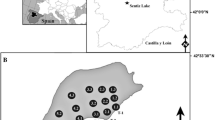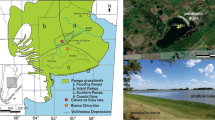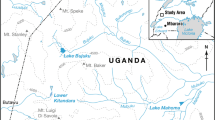Abstract
Due to methodological challenges there are only a few studies that focus on macrophyte dynamics in large lakes despite their notable role in a lake’s ecosystem functioning. This study investigates composition and productivity changes of the submerged vegetation of Lake Karakul, Pamir Mountains (Tajikistan), using sedimentary ancient DNA metabarcoding and elemental (C/N) and isotopic (δ13C, δ15N) measurements of Stuckenia cf. pamirica (Baagøe) Z. Kaplan (Potamogetonaceae) leaf remains. No Stuckenia cf. pamirica leaf remains were found for 28.7–26.1 cal ka BP, when both Potamogetonaceae and Chara (L.) DNA sequences were recorded, suggesting sparse submerged vegetation at the coring site. This agrees with the inference of a deep lake reached using geochemical proxies. From 26.1 to 17.5 cal ka BP a few macrophyte remains and high numbers of Potamogetonaceae sequences were recovered: lake level was probably low, as suggested by other studies on the lake. Another phase of increased numbers of Chara sequences and the absence of Stuckenia cf. pamirica leaf remains was found between 17.5 and 12.2 cal ka BP, which coincides with a lake-level transgression at Lake Karakul as indicated by paleo-shoreline investigations. Analyses of macrophyte remains reveal intermediate paleo-productivity from 6.9 cal ka BP and high paleo-productivity from 2.2 cal ka BP onwards. From comparisons with other studies, we suggest that lake-level changes are the main driver for the submerged vegetation composition and productivity at the coring site in Lake Karakul and underline our conclusions by depicting the present-day distribution of Stuckenia cf. pamirica and Chara within the lake.




Similar content being viewed by others
References
Aichner B, Herzschuh U, Wilkes H (2010) Influence of aquatic macrophytes on the stable carbon isotopic signatures of sedimentary organic matter in lakes on the Tibetan Plateau. Org Geochem 41:706–718. doi:10.1016/j.orggeochem.2010.02.002
Beer R, Heiri O, Tinner W (2007) Vegetation history, fire history and lake development recorded for 6300 years by pollen, charcoal, loss on ignition and chironomids at a small lake in southern Kyrgyzstan (Alay Range, Central Asia). Holocene 17:977–985. doi:10.1177/0959683607082413
Birks HH (2002) Plant Macrofossils. In: Smol JP, Birks HJB, Last WM (eds) Tracking environmental change using lake sediments volume 3: biological techniques and indicators. Kluwer Academic Publisher, Dordrecht, pp 49–74
Blaauw M, Christen JA (2011) Flexible paleoclimate age-depth models using an autoregressive gamma process. Bayesian Anal 6:457–474. doi:10.1214/ba/1339616472
Böhner J (2006) General climatic controls and topoclimatic variations in Central and High Asia. Boreas 35:279–295. doi:10.1111/j.1502-3885.2006.tb01158.x
Boyer F, Mercier C, Bonin A, Le Bras Y, Taberlet P, Coissac E (2016) Obitools: a unix-inspired software package for DNA metabarcoding. Mol Ecol Resour 16:176–182. doi:10.1111/1755-0998.12428
Chambers PA, Lacoul P, Murphy KJ, Thomaz SM (2008) Global diversity of aquatic macrophytes in freshwater. Hydrobiologia 595:9–26. doi:10.1007/s10750-007-9154-6
Coissac E (2012) OligoTag: a program for designing sets of tags for next-generation sequencing of multiplexed samples. In: Pompanon F, Bonin A (eds) Data production and analysis in population genomics. Humana Press, New York, pp 13–31
Cole JJ, Prairie YT, Caraco NF, McDowell WH, Tranvik LJ, Striegl RG, Duarte CM, Kortelainen P, Downing JA, Middelburg JJ, Melack J (2007) Plumbing the global carbon cycle: integrating inland waters into the terrestrial carbon budget. Ecosystems 10:172–185. doi:10.1007/s10021-006-9013-8
Core Team R (2012) R: A language and environment for statistical computing. R Foundation for Statistical Computing, Vienna, Austria
De Barba M, Miquel C, Boyer F, Mercier C, Rioux D, Coissac E, Taberlet P (2014) DNA metabarcoding multiplexing and validation of data accuracy for diet assessment: application to omnivorous diet. Mol Ecol Resour 14:306–323. doi:10.1111/1755-0998.12188
Dean WE, Gorham E (1998) Magnitude and significance of carbon burial in lakes, reservoirs, and peatlands. Geology 26:535–538. doi:10.1130/0091-7613(1998)026<0535:MASOCB>2.3.CO;2
Dortch JM, Owen LA, Caffee MW (2013) Timing and climatic drivers for glaciation across semi-arid western Himalayan-Tibetan orogen. Quat Sci Rev 78:188–208. doi:10.1016/j.quascirev.2013.07.025
Duarte CM (1990) Seagrass nutrient content. Mar Ecol Prog Ser Oldendorf 6:201–207
Duarte CM (1992) Nutrient concentration of aquatic plants: patterns across species. Limnol Oceanogr 37:882–889
Ergashev AE (1979) The origin and typology of the Central Asian lakes and their algal flora. Int Rev Gesamten Hydrobiol 64:629–642
Falkowski P, Scholes RJ, Boyle E, Canadell J, Canfield D, Elser J, Gruber N, Hibbard K, Högberg P, Linder S, Mackenzie FT, Iii BM, Pedersen T, Rosenthal Y, Seitzinger S, Smetacek V, Steffen W (2000) The global carbon cycle: a test of our knowledge of Earth as a system. Science 290:291–296. doi:10.1126/science.290.5490.291
Ficetola GF, Coissac E, Zundel S, Riaz T, Shehzad W, Bessière J, Taberlet P, Pompanon F (2010) An in silico approach for the evaluation of DNA barcodes. BMC Genom 11:434. doi:10.1186/1471-2164-11-434
Ficken KJ, Li B, Swain DL, Eglinton G (2000) An n-alkane proxy for the sedimentary input of submerged/floating freshwater aquatic macrophytes. Org Geochem 31:745–749. doi:10.1016/S0146-6380(00)00081-4
Gälman V, Rydberg J, de-Luna SS, Bindler R, Renberg I (2008) Carbon and nitrogen loss rates during aging of lake sediment: changes over 27 years studied in varved lake sediment. Limnol Oceanogr 53:1076–1082. doi:10.4319/lo.2008.53.3.1076
Gasith A, Hoyer MV (1998) Structuring role of macrophytes in lakes: changing influence along lake size and depth gradients. In: Jeppesen E, Søndergaard M, Søndergaard M, Christoffersen K (eds) The structuring role of submerged macrophytes in lakes. Springer, Berlin, pp 381–392
Gilbert MTP, Binladen J, Miller W, Wiuf C, Willerslev E, Poinar H, Carlson JE, Leebens-Mack JH, Schuster SC (2007) Recharacterization of ancient DNA miscoding lesions: insights in the era of sequencing-by-synthesis. Nucleic Acids Res 35:1–10. doi:10.1093/nar/gkl483
Håkanson L, Boulion VV (2002) Empirical and dynamical models to predict the cover, biomass and production of macrophytes in lakes. Ecol Model 151:213–243. doi:10.1016/S0304-3800(01)00458-6
Hammer UT (1986) Saline lake ecosystems of the world. Springer Science & Business Media, Berlin
Hannon GE, Gaillard M-J (1997) The plant-macrofossil record of past lake-level changes. J Paleolimnol 18:15–28. doi:10.1023/A:1007958511729
Heinecke L, Mischke S, Adler K, Barth A, Biskaborn BK, Plessen B, Nitze I, Kuhn G, Rajabov I, Herzschuh U (2017) Climatic and limnological changes at Lake Karakul (Pamir Mountains) during the last 29 cal kyr BP. J Paleolimnol. doi:10.1007/s10933-017-9980-0
Herzschuh U, Mischke S, Meyer H, Plessen B, Zhang C (2009) Using variations in the stable carbon isotope composition of macrophyte remains to quantify nutrient dynamics in lakes. J Paleolimnol 43:739–750. doi:10.1007/s10933-009-9365-0
Herzschuh U, Mischke S, Meyer H, Plessen B, Zhang C (2010) Lake nutrient variability inferred from elemental (C, N, S) and isotopic (δ13C, δ15N) analyses of aquatic plant macrofossils. Quat Sci Rev 29:2161–2172. doi:10.1016/j.quascirev.2010.05.011
IGBP Terrestrial Carbon Working Group G (1998) The terrestrial carbon cycle: implications for the Kyoto Protocol. Science 280:1393–1394. doi:10.1126/science.280.5368.1393
Jones RI, King L, Dent MM, Maberly SC, Gibson CE (2004) Nitrogen stable isotope ratios in surface sediments, epilithon and macrophytes from upland lakes with differing nutrient status. Freshw Biol 49:382–391. doi:10.1111/j.1365-2427.2004.01194.x
Kaplan Z (2008) A taxonomic revision of Stuckenia (Potamogetonaceae) in Asia, with notes on the diversity and variation of the genus on a worldwide scale. Folia Geobot 43:159–234. doi:10.1007/s12224-008-9010-0
Kearse M, Moir R, Wilson A, Stones-Havas S, Cheung M, Sturrock S, Buxton S, Cooper A, Markowitz S, Duran C, Thierer T, Ashton B, Meintjes P, Drummond A (2012) Geneious basic: an integrated and extendable desktop software platform for the organization and analysis of sequence data. Bioinforma Oxf Engl 28:1647–1649. doi:10.1093/bioinformatics/bts199
Komatsu T, Tsukamoto S (2015) Late Glacial lake-level changes in the Lake Karakul basin (a closed glacierized-basin), eastern Pamirs, Tajikistan. Quat Res 83:137–149. doi:10.1016/j.yqres.2014.09.001
Komatsu T, Watanabe T, Hirakawa K (2010) A framework for Late Quaternary lake-level fluctuations in Lake Karakul, eastern Pamir, focusing on lake–glacier landform interaction. Geomorphology 119:198–211. doi:10.1016/j.geomorph.2010.03.025
Lauterbach S, Witt R, Plessen B, Dulski P, Prasad S, Mingram J, Gleixner G, Hettler-Riedel S, Stebich M, Schnetger B, Schwalb A, Schwarz A (2014) Climatic imprint of the mid-latitude Westerlies in the Central Tian Shan of Kyrgyzstan and teleconnections to North Atlantic climate variability during the last 6000 years. Holocene 24:970–984. doi:10.1177/0959683614534741
Li X, Liu W, Zhou X, Xu L, Cheng P (2015) A 700-year macrophyte productivity record inferred from isotopes of macrophyte remains and bulk carbonates in Lake Koucha, northeast Qinghai-Tibetan Plateau. Quat Int. doi:10.1016/j.quaint.2015.11.053
Mathis M, Sorrel P, Klotz S, Huang X, Oberhänsli H (2014) Regional vegetation patterns at lake Son Kul reveal Holocene climatic variability in central Tien Shan (Kyrgyzstan, Central Asia). Quat Sci Rev 89:169–185. doi:10.1016/j.quascirev.2014.01.023
Meyers PA (1994) Preservation of elemental and isotopic source identification of sedimentary organic matter. Chem Geol 114:289–302. doi:10.1016/0009-2541(94)90059-0
Meyers PA, Lallier-Vergés E (1999) Lacustrine sedimentary organic matter records of Late Quaternary paleoclimates. J Paleolimnol 21:345–372. doi:10.1023/A:1008073732192
Mischke S, Bößneck U, Diekmann B, Herzschuh U, Jin H, Kramer A, Wünnemann B, Zhang C (2009) Quantitative relationship between water-depth and sub-fossil ostracod assemblages in Lake Donggi Cona, Qinghai Province, China. J Paleolimnol 43:589–608. doi:10.1007/s10933-009-9355-2
Mischke S, Rajabov I, Mustaeva N, Zhang C, Herzschuh U, Boomer I, Brown ET, Andersen N, Myrbo A, Ito E, Schudack ME (2010) Modern hydrology and late Holocene history of Lake Karakul, eastern Pamirs (Tajikistan): a reconnaissance study. Palaeogeogr Palaeoclimatol Palaeoecol 289:10–24. doi:10.1016/j.palaeo.2010.02.004
Molchanov LA (1929) Lakes of Central Asia. Trudy Sredneaziat. Gos. Univ., Geografiya 3, Tashkent, pp 26–31
Osmond CB, Valaane N, Haslam SM, Uotila P, Roksandic Z (1981) Comparisons of δ13C values in leaves of aquatic macrophytes from different habitats in Britain and Finland; some implications for photosynthetic processes in aquatic plants. Oecologia 50:117–124. doi:10.1007/BF00378804
Papadimitriou S, Kennedy H, Kennedy DP, Borum J (2005) Seasonal and spatial variation in the organic carbon and nitrogen concentration and their stable isotopic composition in Zostera marina (Denmark). Limnol Oceanogr 50:1084–1095
Paus A, Boessenkool S, Brochmann C, Epp LS, Fabel D, Haflidason H, Linge H (2015) Lake Store Finnsjøen—a key for understanding Lateglacial/early Holocene vegetation and ice sheet dynamics in the central Scandes Mountains. Quat Sci Rev 121:36–51. doi:10.1016/j.quascirev.2015.05.004
Pawluczyk M, Weiss J, Links MG, Aranguren ME, Wilkinson MD, Egea-Cortines M (2015) Quantitative evaluation of bias in PCR amplification and next-generation sequencing derived from metabarcoding samples. Anal Bioanal Chem 407:1841–1848. doi:10.1007/s00216-014-8435-y
Pedersen MW, Ruter A, Schweger C, Friebe H, Staff RA, Kjeldsen KK, Mendoza MLZ, Beaudoin AB, Zutter C, Larsen NK, Potter BA, Nielsen R, Rainville RA, Orlando L, Meltzer DJ, Kjær KH, Willerslev E (2016) Postglacial viability and colonization in North America’s ice-free corridor. Nature 537:45–49. doi:10.1038/nature19085
Penning WE, Mjelde M, Dudley B, Hellsten S, Hanganu J, Kolada A, van den Berg M, Poikane S, Phillips G, Willby N, Ecke F (2008) Classifying aquatic macrophytes as indicators of eutrophication in European lakes. Aquat Ecol 42:237–251. doi:10.1007/s10452-008-9182-y
Ricketts RD, Johnson TC, Brown ET, Rasmussen KA, Romanovsky VV (2001) The Holocene paleolimnology of Lake Issyk-Kul, Kyrgyzstan: trace element and stable isotope composition of ostracodes. Palaeogeogr Palaeoclimatol Palaeoecol 176:207–227. doi:10.1016/S0031-0182(01)00339-X
Sand-Jensen K (1983) Photosynthetic carbon sources of stream macrophytes. J Exp Bot 34:198–210. doi:10.1093/jxb/34.2.198
Sayer CD, Burgess A, Kari K, Davidson TA, Peglar S, Yang H, Rose N (2010) Long-term dynamics of submerged macrophytes and algae in a small and shallow, eutrophic lake: implications for the stability of macrophyte-dominance. Freshw Biol 55:565–583. doi:10.1111/j.1365-2427.2009.02353.x
Schirmer M, D’Amore R, Ijaz UZ, Hall N, Quince C (2016) Illumina error profiles: resolving fine-scale variation in metagenomic sequencing data. BMC Bioinform 17:125. doi:10.1186/s12859-016-0976-y
Schnell IB, Bohmann K, Gilbert MTP (2015) Tag jumps illuminated—reducing sequence-to-sample misidentifications in metabarcoding studies. Mol Ecol Resour 15:1289–1303. doi:10.1111/1755-0998.12402
Seong YB, Owen LA, Yi C, Finkel RC (2009) Quaternary glaciation of Muztag Ata and Kongur Shan: evidence for glacier response to rapid climate changes throughout the Late Glacial and Holocene in westernmost Tibet. Geol Soc Am Bull 121:348–365. doi:10.1130/B26339.1
Sjögren P, Edwards ME, Gielly L, Langdon CT, Croudace IW, Merkel MKF, Fonville T, Alsos IG (2016) Lake sedimentary DNA accurately records 20th Century introductions of exotic conifers in Scotland. New Phytol 213:929–941. doi:10.1111/nph.14199
Strayer DL, Dudgeon D (2010) Freshwater biodiversity conservation: recent progress and future challenges. J North Am Benthol Soc 29:344–358. doi:10.1899/08-171.1
Strecker MR, Frisch W, Hamburger MW, Ratschbacher L, Semiletkin S, Zamoruyev A, Sturchio N (1995) Quaternary deformation in the Eastern Pamirs, Tadzhikistan and Kyrgyzstan. Tectonics 14:1061–1079. doi:10.1029/95TC00927
Taberlet P, Coissac E, Pompanon F, Gielly L, Miquel C, Valentini A, Vermat T, Corthier G, Brochmann C, Willerslev E (2007) Power and limitations of the chloroplast trnL (UAA) intron for plant DNA barcoding. Nucleic Acids Res 35:e14–e14. doi:10.1093/nar/gkl938
Taft L, Mischke S, Wiechert U, Leipe C, Rajabov I, Riedel F (2014) Sclerochronological oxygen and carbon isotope ratios in Radix (Gastropoda) shells indicate changes of glacial meltwater flux and temperature since 4,200 cal yr BP at Lake Karakul, eastern Pamirs (Tajikistan). J Paleolimnol 52:27–41. doi:10.1007/s10933-014-9776-4
Talbot MR (2002) Nitrogen isotopes in palaeolimnology. In: Last WM, Smol JP (eds) Tracking environmental change using lake sediments, vol 2. Physical and Geochemical Methods. Kluwer Academic Publishers, Dordrecht, pp 401–439
Talevska M, Talevski T (2015) Qualitative composition of macrophyte vegetation and cyprinid fauna from Lake Ohrid. Bulg J Agric Sci 21:68–75
Van den Berg MS, Coops H, Simons J, de Keizer A (1998) Competition between Chara aspera and Potamogeton pectinatus as a function of temperature and light. Aquat Bot 60:241–250. doi:10.1016/S0304-3770(97)00099-5
Van den Berg MS, Coops H, Simons J, Pilon J (2002) A comparative study of the use of inorganic carbon resources by Chara aspera and Potamogeton pectinatus. Aquat Bot 72:219–233. doi:10.1016/S0304-3770(01)00202-9
Van Wijk RJ (1989) Ecological studies on Potamogeton pectinatus L. III. Reproductive strategies and germination ecology. Aquat Bot 33:271–299. doi:10.1016/0304-3770(89)90042-9
Waters JM, Fraser CI, Hewitt GM (2013) Founder takes all: density-dependent processes structure biodiversity. Trends Ecol Evol 28:78–85. doi:10.1016/j.tree.2012.08.024
Zhao Y, Sayer CD, Birks HH, Hughes M, Peglar SM (2006) Spatial representation of aquatic vegetation by macrofossils and pollen in a small and shallow lake. J Paleolimnol 35:335–350. doi:10.1007/s10933-005-1336-5
Acknowledgements
We thank Ilhomjon Rajabov for logistical support in Tajikistan during the 2008 and 2012 expeditions and Thomas J. Whitmore and two anonymous reviews for their comments, which helped to improve this manuscript. We appreciate the financial support of the DFG (PhD scholarship for LH in the DFG Graduate School 1364, grants Mi 730/15-1 and 15-2 to SM, as well as grant EP 98/2-1 to LSE).
Data Availability
The paleo-genetic dataset, macrophyte measurement results and the raw data of the Ilumina HiSeq sequencing run are available at Pangaea (https://doi.pangaea.de/10.1594/PANGAEA.877361).
Author information
Authors and Affiliations
Corresponding authors
Electronic supplementary material
Below is the link to the electronic supplementary material.
Rights and permissions
About this article
Cite this article
Heinecke, L., Epp, L.S., Reschke, M. et al. Aquatic macrophyte dynamics in Lake Karakul (Eastern Pamir) over the last 29 cal ka revealed by sedimentary ancient DNA and geochemical analyses of macrofossil remains. J Paleolimnol 58, 403–417 (2017). https://doi.org/10.1007/s10933-017-9986-7
Received:
Accepted:
Published:
Issue Date:
DOI: https://doi.org/10.1007/s10933-017-9986-7




